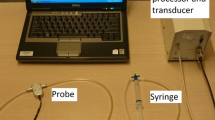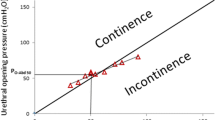Abstract
The aim of this study was to determine whether water perfusion maximum urethral closure pressure (MUCP) correlates with Valsalva leak-point pressure (LPP), and which of these best correlates with subjective and objective incontinence severity measures. Fifty-two women with previously diagnosed genuine stress incontinence (n= 46), or mixed incontinence with a minor and controlled urge component (n= 6), were assigned an incontinence status grade based on interview and diary review. These women then completed visually observed standing LPPs at 250 ml bladder capacity, supine water perfusion MUCP determinations, pad tests and quality of life questionnaires. The urodynamic and severity measures were compared with correlation analysis or analysis of variance. A modest correlation exists between LPP and MUCP (r= 0.50–0.62, P<0.001). Both MUCP and LPP demonstrated significant decreases (P<0.01) with increasing severity of assigned incontinence grade. A very low and insignificant correlation existed for these urodynamic parameters and pad loss or quality of life measures. MUCP and LPP correlate modestly with each other and both are comparable in predicting incontinence severity. Either can be used as the urodynamic measure to assess intrinsic sphincter deficiency.
Similar content being viewed by others
Author information
Authors and Affiliations
Rights and permissions
About this article
Cite this article
Nager, C., Schulz, J., Stanton, S. et al. Correlation of Urethral Closure Pressure, Leak-Point Pressure and Incontinence Severity Measures. Int Urogynecol J 12, 395–400 (2001). https://doi.org/10.1007/s001920170020
Published:
Issue Date:
DOI: https://doi.org/10.1007/s001920170020




